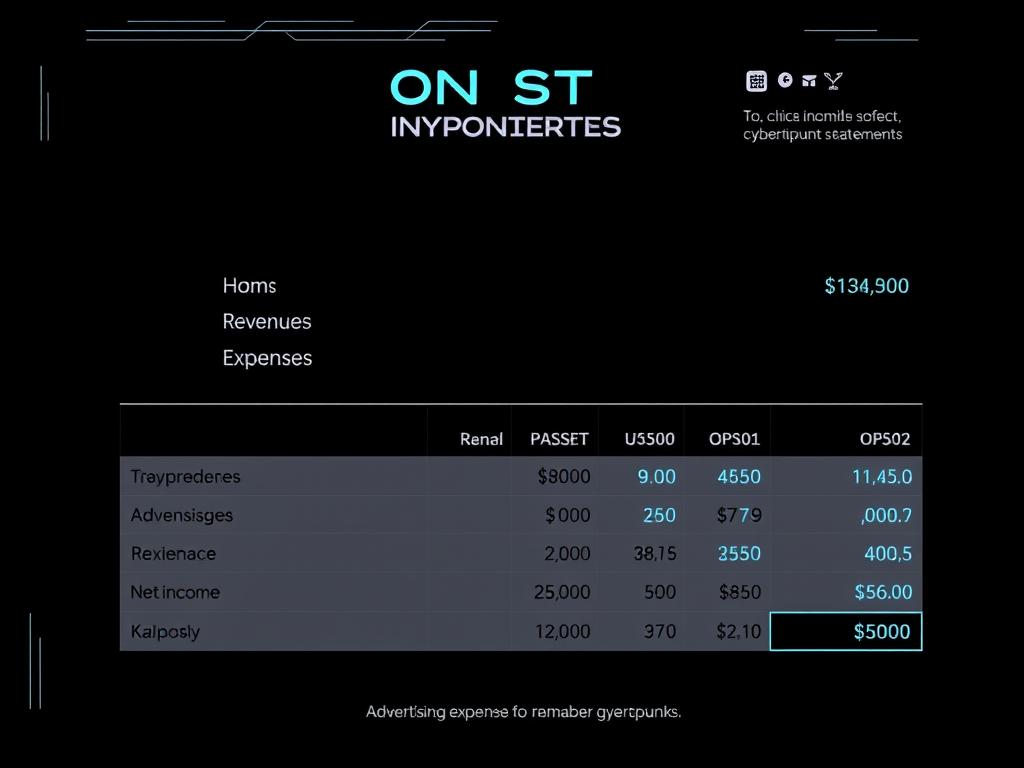In the realm of financial accounting, understanding where advertising costs appear in financial statements is crucial for business owners and financial managers. Advertising expenses are integral to promoting your brand, offerings, and overall business presence in the market. These costs can cover print ads, online promotions, broadcast slots, radio time, and even direct mail campaigns. So, where do these expenses show up in your financial records?
Typically, advertising costs are recognized within two key financial statements: the income statement and the balance sheet. On the income statement, you’ll find advertising expenses classified as part of the operating expenses, often under sales, general, and administrative (SG&A) categories. On the balance sheet, these costs may initially be recorded as prepaid expenses, especially if they are incurred in advance of realizing related sales. The transfer from the balance sheet occurs once the associated sales are made, ensuring accurate financial tracking and reporting.
According to the U.S. Small Business Administration, many businesses base their advertising budgets on a percentage of revenue. Manufacturers and wholesalers, for example, spend around 0.7% of their annual revenues on advertising. Service companies and B2C firms often allocate a higher budget compared to product and B2B companies. Moreover, media outlets may offer significant discounts—ranging from 40% to 50%—for advertising slots that get cancelled, making it essential to negotiate wisely and leverage such opportunities.
Properly categorizing and recording advertising expenses is fundamental for financial health and compliance. These expenses boost product awareness and brand loyalty, ultimately aiming to increase sales and market share. As you delve deeper into understanding how advertising costs are treated in financial accounting, you’ll appreciate the importance of meticulous tracking and reporting for sound business management.
Understanding Advertising Costs
Advertising costs are crucial for businesses aiming to enhance brand visibility and market reach. Grasping the nuances of these expenses is fundamental to sound financial management and strategic planning.
Definition of Advertising Expense
The advertising expense definition encompasses the costs incurred from the paid distribution of a marketing message across different channels. These channels may include print, radio, television, online platforms, and direct mail. Typically, advertising expenses are part of operating expenses on the income statement and are recognized in the period they occur. The IRS allows businesses to deduct these costs as ordinary and necessary business expenses.
Categories of Advertising Costs
Understanding the various advertising cost categories helps businesses allocate their budgets effectively. Common categories include:
- Media Buys
- Production Costs
- Digital Advertising
- Print Materials
- Event Sponsorships
- Public Relations
Advertising expenses are recorded as operating expenses on the income statement, debiting the Advertising Expense account and crediting Cash or Accounts Payable. Tools like Ramp can help streamline and manage these expenses efficiently.
Difference Between Advertising and Promotion Expenses
While advertising and promotional expenses both aim to increase brand awareness, they serve slightly different purposes. Advertising expenses are specific to paid media placement and tracked as distinct budget items under Marketing and Promotions or Sales. Promotional expenses, on the other hand, are more general activities like giveaways, samples, and sweepstakes. These expenses are also recognized differently across financial statements based on the business’s accounting practices.
| Criteria | Advertising Expenses | Promotional Expenses |
|---|---|---|
| Primary Goal | Boost brand/product awareness through paid channels | Increase brand awareness through general activities |
| Typical Activities | Media buys, TV/radio ads | Giveaways, sweepstakes |
| Financial Classification | Operating Expenses | Operating Expenses |
| Examples | Digital ads, event sponsorships | Samples, contests |
Where Advertising Expenses Appear in Financial Statements
Understanding where advertising expenses appear in financial statements is crucial for effective financial management. These expenses impact both the income statement and the balance sheet, influencing the perceived financial health of a company.
The Income Statement
Advertising expenses are most commonly found on the income statement within the Selling, General & Administrative Expenses (SG&A) section. Here, they are often merged with marketing or selling expenses. Reporting these expenses as part of the income statement allows businesses to directly match the costs with the revenue they help to generate. According to SOP 93-7, normal advertising costs should be expensed when incurred or when the advertisement first runs. Media costs like broadcast media or direct mail are expensed immediately upon first use.
The Balance Sheet
Initially, some advertising costs may be recorded as prepaid expenses on the balance sheet. For example, prepaid advertising expenses might show up as an advertising asset if future sales are anticipated from a specific advertising campaign. As time progresses and the advertising activities take effect, these prepaid expenses transition from being an asset on the balance sheet to an expense on the income statement. This shift adheres to the accounting principle of matching expenses with the revenue they generate.
Advertising as an Asset or an Expense
The categorization of advertising as either an asset or an expense depends on the specifics of the advertising activity. According to SOP 93-7 and GAAP, most advertising expenses are treated as expenses. However, direct-response advertising can be capitalized if there is credible evidence indicating that the primary purpose of the advertising is to generate customers directly from the advertising effort. This makes it unique among other advertising types, typically expensed immediately.

| Expense Type | Income Statement | Balance Sheet |
|---|---|---|
| Advertising Expense | Reported under SG&A | Not Applicable |
| Prepaid Advertising | Not Applicable | Recorded as Prepaid Asset |
| Direct-Response Advertising | Capitalized if criteria met | Initially recorded as Asset |
| Production Costs | Expensed when incurred | Not Applicable |
Recording Advertising Costs
Understanding how to record advertising costs is crucial for maintaining accurate financial statements. This process ensures that expenses are recognized at the appropriate time, providing clear insight into a company’s financial health.
Prepaid Advertising
Initially, prepaid advertising is treated as an asset on the balance sheet. For instance, when a company pays in advance for an advertisement set to be released during a future event, it is recorded under prepaid advertising. This asset remains on the balance sheet until the advertising services are performed.
At the end of each period, adjusting entries are necessary to update the accounts. The prepaid advertising is then moved to the advertising expense account as the services are utilized. Monthly adjusting entries provide a more accurate picture of the financial position.
Timing of Advertising Expense Recognition
Expense recognition for advertising costs needs to be managed carefully. When advertising services are performed and the benefits start to materialize, these costs are transferred to the advertising expense category on the income statement. Recording the used portion in advertising expenses, while the unused portion remains in prepaid advertising, ensures compliance with financial reporting standards.
For example, according to US GAAP, advanced payments for advertising may initially be recorded under “Advertising Expense,” whereas IFRS often requires costs to be expensed as they are incurred. This distinction highlights the importance of understanding the accounting standards your business is following.
Examples of Advertising Costs in Financial Statements
To illustrate, consider the upfront payment for an ad campaign scheduled to appear during a major sporting event. Initially, this payment is recorded as prepaid advertising on the balance sheet. Once the ad airs, it is shifted to the advertising expense on the income statement.
| Financial Statement | Prepaid Advertising | Advertising Expense |
|---|---|---|
| Initial Payment | Recorded as Asset | Not Yet Recorded |
| Post-Ad Release | Reduced | Recorded as Expense |
Sales materials such as brochures and catalogs could also be accounted for as prepaid supplies until they are used. Once these materials are distributed, they are recognized as an advertising expense.
How Businesses Budget for Advertising Expenses
When determining the advertising budget, businesses need to consider several factors to ensure the effective allocation of resources. Generally, companies budget their advertising expenses as a percentage of their total revenue. For instance, Business-to-Business (B2B) companies typically spend 2%-5% of their revenue on advertising, while Business-to-Consumer (B2C) companies may allocate 5%-10%. Such allocation helps companies maintain a consistent marketing spend aligned with their revenue-based budgeting strategy.

- Percentage of Sales Method: Companies assign a fixed percentage of their sales revenue to the advertising budget. This method simplifies budgeting but may not always align with strategic goals.
- Objective and Task Method: Large corporations prefer this method, focusing on the relationship between marketing tasks and overall objectives.
- Competitive Parity Method: This approach benchmarks spending against competitors to avoid being out-advertised in the market.
Revenue-based budgeting is crucial for growth-stage companies. These businesses often allocate 10%-20% of their gross revenue to digital marketing to drive higher returns. On the other hand, established companies might allocate less, around 6.4%-9.5%, reflecting stable growth trends.
To understand the advertising spend across different sectors, consider the following:
| Sector | Percentage of Revenue |
|---|---|
| Service Consulting and Technology | 21% |
| Healthcare | 18% |
| Banking, Finance, Insurance, Real Estate | 8% |
| Education | 3% |
| Publicly Traded Companies | 11% |
Lastly, companies must decide on how to allocate their advertising budget wisely among various channels such as digital, traditional media, public relations, and more. Publicly traded companies, for example, spend up to 75% of their marketing budget on digital advertising. Ensuring the right balance can significantly impact their operating income and overall success.
Importance of Properly Tracking Advertising Expenses
In today’s competitive market, properly tracking advertising expenses is pivotal for businesses aiming to maintain a healthy financial status. By understanding and managing the impact of advertising on profit margins, measuring return on investment (ROI), and adhering to financial reporting standards, companies can make informed decisions that boost their overall profitability and market share.
Impact on Profit Margins
Accurately tracking advertising expenses directly affects your profit margin. By identifying and controlling spending, you can ensure that marketing efforts contribute positively to your bottom line. Implementing a detailed breakdown of advertising costs—such as employee salaries, sales commissions, and direct mail expenses—offers insights on where to allocate resources for maximum efficiency. Tools like the advertising-to-sales ratio are instrumental in measuring how much revenue is generated per advertising dollar spent.
Measuring Return on Investment (ROI)
Calculating the return on investment (ROI) of advertising campaigns is essential for determining their effectiveness. Metrics such as Customer Acquisition Cost (CAC) and the SaaS Magic Number help assess the financial benefits gained from marketing investments. By consistently measuring ROI, you can identify high-performing campaigns and reallocate funds from less effective channels to those with higher returns, leading to optimized marketing strategies and better financial outcomes.
Adherence to Financial Reporting Standards
Adherence to financial reporting standards is crucial for maintaining transparency and accountability in a business’s financial statements. Tracking advertising expenses accurately ensures that all costs are reported in compliance with these standards, providing a clear and truthful picture of financial health to stakeholders and investors. This transparency is vital for building trust and facilitating informed decision-making regarding future marketing investments.
How Does Advertising Revenue Relate to Advertising Expense on Financial Statements?
On financial statements, companies balance advertising expenses against the income generated from promotional activities. Advertising revenue explained as earnings derived from advertisements highlights its direct impact on profitability. By comparing revenue with expenses, businesses evaluate marketing efficiency, ensuring that their advertising strategies yield a positive return on investment to drive sustainable growth.
Conclusion
Effectively managing your advertising expense is crucial to your business’s overall financial health and strategic growth. By comprehensively understanding where these costs appear on financial statements, you can enhance your advertising expense management and gain deeper insights into your financial planning and budgeting processes. Advertising expenses, whether categorized as assets or liabilities, play a substantial role in shaping your fiscal projections.
The guidelines provided by the AICPA’s AcSEC in the SOP issued in May 1994 further emphasize the importance of correctly accounting for advertising costs. These rules ensure that advertising expenditures are expensed either in the periods they are incurred or when the advertisement first runs. This methodology not only aligns with proper financial reporting standards but also enhances the clarity and comparability among different entities.
Considering some industry giants like ExxonMobil Corporation, who reported total assets of $376.3 billion for fiscal year 2023, it’s evident that comprehensive expense management impacts all financial aspects including revenue and net income. Precise and strategic advertising expense management is not just about adhering to standards but also about enhancing your company’s long-term growth and profitability. For a detailed understanding of the reporting standards, you can refer to resources like PwC’s financial statement guide.








